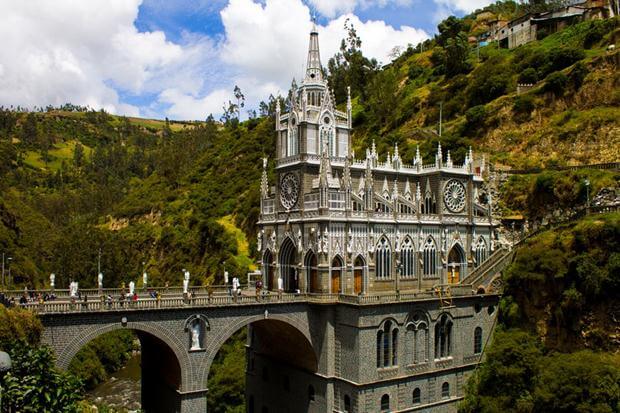
Photo: amazingplacesonearth.com
Las Lajas Cathedral
Las Lajas Sanctuary is a minor basilica church located in the southern Colombian Department of Nariño, municipality of Ipiales and built inside the canyon of the Guáitara River.
The present church was built-in Gothic Revival style in 1949. The name Laja comes from the name of a type of flat sedimentary rock similar to shale.
The inspiration for the church’s creation was a result of a miraculous event in 1754 when an Amerindian named Maria Mueces and her deaf-mute daughter Rosa were caught in a very strong storm.
The two sought refuge between the gigantic Lajas, when to Maria Mueces’s surprise, her mute daughter, Rosa exclaimed “the mestiza is calling me…” and pointed to the lightning-illuminated silhouette over the laja. This apparition of the Virgin Mary caused pilgrimage to this location, with occasional miraculous cases of healing reported. The image on the stone is still visible today.
The existence of a shrine in this location was recorded in the accounts of friar Juan de Santa Gertrudis’s journey through the southern region of the New Kingdom of Granada between 1756 and 1764. The first shrine was built here in the middle of 18th century from straw and wood. It was replaced with a new, larger shrine in 1802, which in turn was extended and connected to the opposite side of canyon with a bridge.
Current church was built-in the time period from January 1, 1916 to August 20, 1949, with donations from local churchgoers. It rises 100 m high from the bottom of canyon and is connected with 50 m tall bridge to the opposite side of the canyon.

Photo: travelmoodz.com
Sagrada Família
The Basílica i Temple Expiatori de la Sagrada Família commonly known as the Sagrada Família, is a large Roman Catholic church in Barcelona, Catalonia, Spain, designed by Catalan architect Antoni Gaudí (1852–1926). Although incomplete, the church is a UNESCO World Heritage Site, and in November 2010 was consecrated and proclaimed a minor basilica by Pope Benedict XVI.
Though construction of Sagrada Família had commenced in 1882, Gaudí became involved in 1883, taking over the project and transforming it with his architectural and engineering style—combining Gothic and curvilinear Art Nouveau forms.
Gaudí devoted his last years to the project and at the time of his death in 1926, less than a quarter of the project was complete. Sagrada Família’s construction progressed slowly as it relied on private donations and was interrupted by the Spanish Civil War—only to resume intermittent progress in the 1950s. Construction passed the mid-point in 2010 with some of the project’s greatest challenges remaining and an anticipated completion date of 2026—the centennial of Gaudí’s death.
The basílica has a long history of dividing the citizens of Barcelona—over the initial possibility it might compete with Barcelona’s cathedral, over Gaudí’s design itself, over the possibility that work after Gaudí’s death disregarded his design, and the recent possibility that an underground tunnel of Spain’s high-speed train could disturb its stability.
Describing Sagrada Familia, art Critic Rainer Zerbst said “it is probably impossible to find a church building anything like it in the entire history of art” and Paul Goldberger called it ‘the most extraordinary personal interpretation of Gothic architecture since the Middle Ages’.

Photo: wondermondo.com
St. Basil’s Cathedral
The Cathedral of the Protection of Most Holy Theotokos on the Moat popularly known as Saint Basil’s Cathedral is a Russian Orthodox church erected on the Red Square in Moscow in 1555–61. Built on the order of Ivan the Terrible to commemorate the capture of Kazan and Astrakhan, it marks the geometric centre of the city and the hub of its growth since the 14th century. It was the tallest building in Moscow until the completion of the Ivan the Great Bell Tower in 1600.
The original building, known as “Trinity Church” and later “Trinity Cathedral”, contained eight side churches arranged around the ninth, central church of Intercession; the tenth church was erected in 1588 over the grave of venerated local saint Vasily (Basil). In the 16th and 17th centuries the church, perceived as the earthly symbol of the Heavenly City, as happens to all churches in Byzantine Christianity, was popularly known as the “Jerusalem” and served as an allegory of the Jerusalem Temple in the annual Palm Sunday parade attended by the Patriarch of Moscow and the tsar.
The building’s design, shaped as a flame of a bonfire rising into the sky, has no analogues in Russian architecture: “It is like no other Russian building. Nothing similar can be found in the entire millennium of Byzantine tradition from the fifth to fifteenth century … a strangeness that astonishes by its unexpectedness, complexity and dazzling interleaving of the manifold details of its design.” The cathedral foreshadowed the climax of Russian national architecture in the 17th century.
A victim of state atheism, the church was confiscated from the Russian Orthodox community as part of the Soviet Union’s anti-theist campaigns and has operated as a division of the State Historical Museum since 1928. It was completely and forcefully secularized in 1929and, as of 2011, remains a federal property of the Russian Federation. The church has been part of the Moscow Kremlin and Red Square UNESCO World Heritage Site since 1990. It is often mislabelled as the Kremlin owing to its location on Red Square in immediate proximity of the Kremlin.
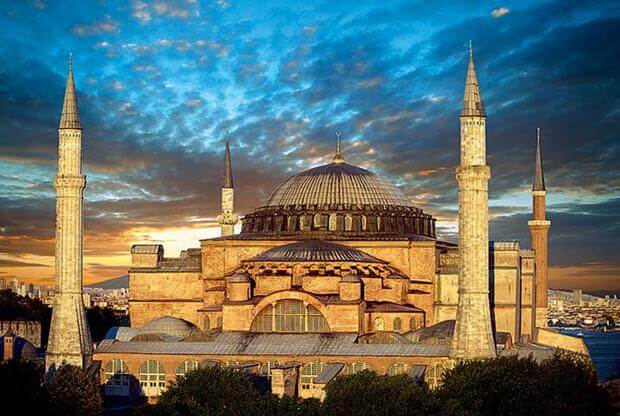
Photo: arounddeglobe.com
Hagia Sophia
Hagia Sophia is a former Orthodox patriarchal basilica, later a mosque, and now a museum in Istanbul, Turkey. From the date of its dedication in 360 until 1453, it served as the Greek Patriarchal cathedral of Constantinople, except between 1204 and 1261, when it was converted to a Roman Catholic cathedral under the Latin Patriarch of Constantinople of the Western Crusader established Latin Empire. The building was a mosque from 29 May 1453 until 1931, when it was secularized. It was opened as a museum on 1 February 1935.
The Church was dedicated to the Logos, the second person of the Holy Trinity, its dedication feast taking place on 25 December, the anniversary of the Birth of the incarnation of the Logos in Christ. Although it is sometimes referred to as Sancta Sophia “Church of the Holy Wisdom of God”.
Famous in particular for its massive dome, it is considered the epitome of Byzantine architecture and is said to have “changed the history of architecture.” It was the largest cathedral in the world for nearly a thousand years, until Seville Cathedral was completed in 1520. The current building was originally constructed as a church between 532 and 537 on the orders of the Byzantine Emperor Justinian and was the third Church of the Holy Wisdom to occupy the site, the previous two having both been destroyed by rioters. It was designed by the Greek scientists Isidore of Miletus, a physicist, and Anthemius of Tralles, a mathematician.
The church contained a large collection of holy relics and featured, among other things, a 49-foot (15 m) silver iconostasis. It was the seat of the Patriarch of Constantinople and the religious focal point of the Eastern Orthodox Church for nearly one thousand years. It is the church in which Cardinal Humbert in 1054 excommunicated Michael I Cerularius – which is commonly considered the start of the Great Schism.
In 1453, Constantinople was conquered by the Ottoman Turks under Sultan Mehmed II, who subsequently ordered the building converted into a mosque. The bells, altar, iconostasis, and sacrificial vessels were removed and many of the mosaics were plastered over. Islamic features – such as the mihrab, minbar, and four minarets – were added while in the possession of the Ottomans. It remained a mosque until 1931 when it was closed to the public for four years. It was re-opened in 1935 as a museum by the Republic of Turkey.
For almost 500 years the principal mosque of Istanbul, Hagia Sophia served as a model for many other Ottoman mosques, such as the Sultan Ahmed Mosque the Şehzade Mosque, the Süleymaniye Mosque, the Rüstem Pasha Mosque and the Kılıç Ali Paşa Mosque.

Photo: grayline.com
St. Peter’s Basilica
The Papal Basilica of Saint Peter , officially known in Italian as Basilica Papale di San Pietro in Vaticano and commonly known as Saint Peter’s Basilica, is a Late Renaissance church located within the Vatican City. Saint Peter’s Basilica has the largest interior of any Christian church in the world. While it is neither the official mother church of the Roman Catholic Church nor the cathedral of the Pope as Bishop of Rome, Saint Peter’s is regarded as one of the holiest Catholic sites. It has been described as “holding a unique position in the Christian world” and as “the greatest of all churches of Christendom”.
In Roman Catholic tradition, the basilica is the burial site of its namesake Saint Peter, who was one of the twelve apostles of Jesus and, according to tradition, the first Bishop of Rome and therefore first in the line of the papal succession. Tradition and some historical evidence hold that Saint Peter’s tomb is directly below the altar of the basilica. For this reason, many Popes have been interred at St. Peter’s since the Early Christian period. There has been a church on this site since the 4th century. Construction of the present basilica, over the old Constantinian basilica, began on 18 April 1506 and was completed on 18 November 1626.
St. Peter’s is famous as a place of pilgrimage, for its liturgical functions and for its historical associations. It is associated with the papacy, with the Counter-reformation and with numerous artists, most significantly Michelangelo. As a work of architecture, it is regarded as the greatest building of its age. Contrary to popular misconception, Saint Peter’s is not a cathedral, as it is not the seat of a bishop. It is properly termed a papal basilica. The Archbasilica of St. John Lateran is the cathedral church of Rome.
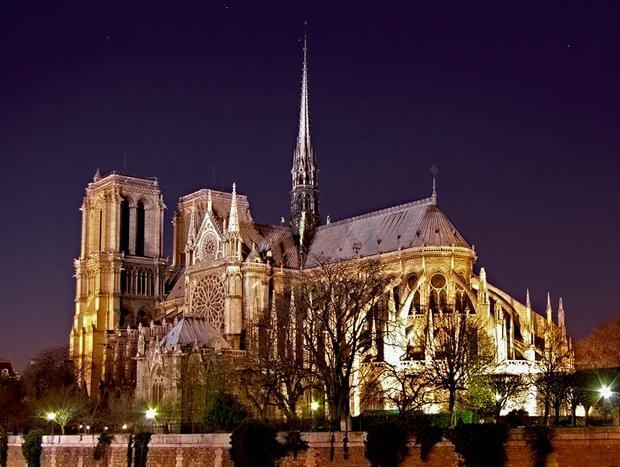
Photo: wondermondo.com
Notre Dame
Notre Dame de also known as Notre Dame Cathedral or simply Notre Dame, is a Gothic, Roman Catholic cathedral on the eastern half of the Île de la Cité in the fourth arrondissement of Paris, France. It is the cathedral of the Catholic Archdiocese of Paris: that is, it is the church that contains the cathedra (official chair) of the Archbishop of Paris, currently André Vingt-Trois. The cathedral treasury houses a reliquary with the purported Crown of Thorns.
Notre Dame de Paris is widely considered one of the finest examples of French Gothic architecture in France and in Europe, and the naturalism of its sculptures and stained glass are in contrast with earlier Romanesque architecture. The first period of construction from 1163 into 1240s coincided with the musical experiments of the Notre Dame school.
The cathedral suffered desecration during the radical phase of the French Revolution in the 1790s, when much of its religious imagery was damaged or destroyed. An extensive restoration supervised by Eugène Viollet-le-Duc removed remaining decoration, returning the cathedral to an ‘original’ gothic state.
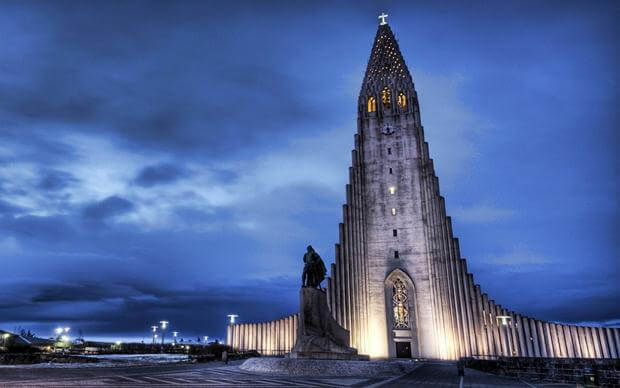
Photo: thousandwonders.net
Hallgrimskirkja
The Hallgrímskirkja is a Lutheran (Church of Iceland) parish church in Reykjavík, Iceland. At 74.5 metres (244 ft), it is the largest church in Iceland and the sixth tallest architectural structure in Iceland after Longwave radio mast Hellissandur, the radio masts of US Navy at Grindavík, Eiðar longwave transmitter and Smáratorg tower. The church is named after the Icelandic poet and clergyman Hallgrímur Pétursson (1614 to 1674), author of the Passion Hymns.
State Architect Guðjón Samúelsson’s design of the church was commissioned in 1937. He is said to have designed it to resemble the basalt lava flows of Iceland’s landscape. It took 38 years to build the church. Construction work began in 1945 and ended in 1986, the landmark tower being completed long before the church’s actual completion.
The crypt beneath the choir was consecrated in 1948, the steeple and wings were completed in 1974. The nave was consecrated in 1986. Situated in the centre of Reykjavík, it is one of the city’s best-known landmarks and is visible throughout the city. It is similar in style to the expressionist architecture of Grundtvig’s Church of Copenhagen, Denmark, completed in 1926.
The church houses a large pipe organ by the German organ builder Johannes Klais of Bonn. It has mechanical action, four manuals and pedal, 102 ranks, 72 stops and 5275 pipes. It is 15 metres tall and weighs 25 tons. Its construction was finished in December 1992. It has been recorded by Christopher Herrick in his Organ Fireworks VII CD.
The church is also used as an observation tower. An observer can take a lift up to the viewing deck and view Reykjavík and the surrounding mountains. The statue of explorer Leif Eriksson (1929–32) by Alexander Stirling Calder in front of the church predates its construction. It was a gift from the United States in honor of the 1930 Alþingi Millennial Festival, commemorating the 1000th anniversary of Iceland’s parliament at Þingvellir in 930 AD.
In 2008, the church underwent a major restoration of the main tower, and was covered in scaffolding. In late 2009, restoration was completed and the scaffolding was removed.
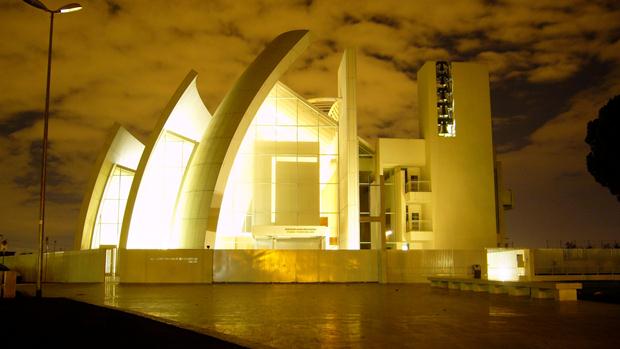
Photo: openbuildings.com
Jubilee Church
The Jubilee Church, formally known as Dio Padre Misericordioso, is a church and community center in Tor Tre Teste in Rome. According to Richard Meier, its architect, it is “the crown jewel of the Vicariato di Roma’s (Archdiocese of Rome) Millennium project” (p. 354). The Church serves eight thousand residents of the Tor Tre Teste area and was meant to socially “revive” Tor Tre Teste. It is paid homage to in the video game Hitman: Blood Money, with a very similar church as the setting of the game’s final mission.
he south side of the church features three large curved walls of pre-cast concrete. (The walls form segments of spheres.) Meier claims to have designed the church to minimize thermal peak loads inside. The large thermal mass of the concrete walls control internal heat gain; the result is less temperature variation, and supposedly more efficient use of energy.
The walls also contain titanium dioxide to keep the appearance of the church white. Enrico Borgarello, the director of research and development for Italcementi, the company that designed the cement, claims that the cement destroys air pollution.
The Church’s site is divided into four main parts: first, the precinct, including the church and community center; second, the northeast terrace; third, the northwest recreation court; fourth, the west parking area.
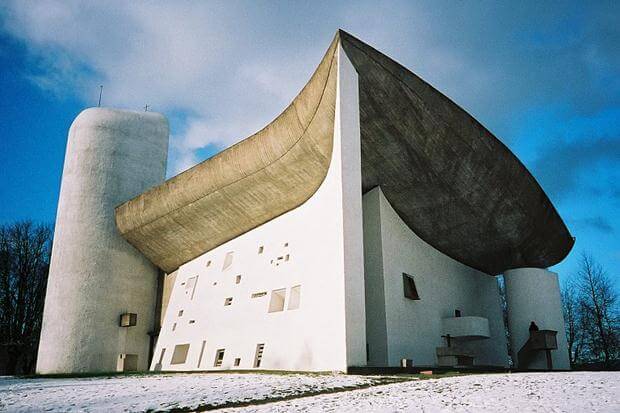
Photo: bluffton.edu
Notre Dame du Haut
The chapel of Notre Dame du Haut, designed by Le Corbusier, is located in Ronchamp. The Chapelle Notre-Dame-du-Haut, a shrine for the Catholic Church at Ronchamp was built for a reformist Church looking to continue its relevancy. Warning against decadence, reformers within the Church looked to renew its spirit by embracing modern art and architecture as representative concepts. Father Couturier, who would also sponsor Le Corbusier for the La Tourette commission, steered the unorthodox project to completion in 1954.
This work, like several others in Le Corbusier’s late oeuvre, departs from his principles of standardization and the machine aesthetic outlined in Vers une architecture. It is interesting to note though, that even in this project, the structural design of the roof was inspired by the engineering of airfoils.
The chapel is clearly a site-specific response. By Le Corbusier’s own admission, it was the site that provided an irresistible genius loci for the response, with the horizon visible on all four sides of the hill and its historical legacy for centuries as a place of worship.
This historical legacy weaved in different layers into the terrain — from the Romans and sun-worshippers before them, to a cult of the Virgin in the Middle Ages, right through to the modern church and the fight against the German occupation. Le Corbusier also sensed a sacral relationship of the hill with its surroundings, the Jura mountains in the distance and the hill itself, dominating the landscape.
The nature of the site would result in an architectural ensemble that has many similitudes with the Acropolis, starting from the ascent at the bottom of the hill to architectural and landscape events along the way, before finally terminating at the sanctum sanctorum itself, the chapel.
The building itself is a comparatively small structure enclosed by thick walls, with the upturned roof supported on columns embedded within the walls. In the interior, the spaces left between the wall and roof, as well as asymmetric light from the wall openings serve to further reinforce the sacral nature of the space and buttress the relationship of the building with its surroundings.
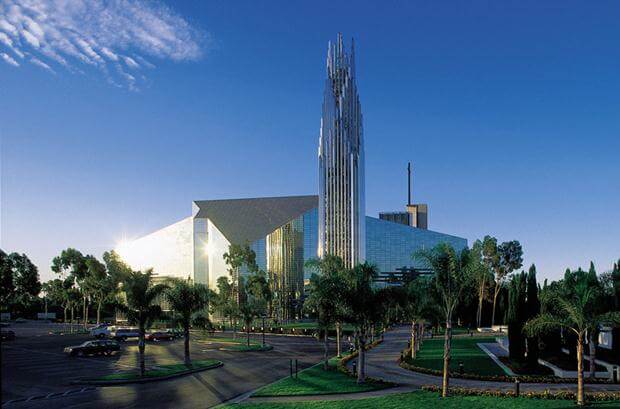
Photo: sinaiticus
The Crystal Cathedral
The Crystal Cathedral is a Christian church building in Garden Grove, Orange County, California, United States. The building, designed by architect Philip Johnson, was completed in 1981 and seats 2,736 people.
Since its construction the building has been the principal place of worship for Crystal Cathedral Ministries, a Protestant Christian church organization founded in 1955 by Robert H. Schuller and affiliated with the Reformed Church in America.
Crystal Cathedral Ministries filed for bankruptcy in October 2010 and subsequently, in February 2012, sold the building and its adjacent campus to the Roman Catholic Diocese of Orange for future use as the diocese’s cathedral. Under the terms of the sale the building and most of the campus will continue to be used by Crystal Cathedral Ministries for up to three years before being renovated for use as a Roman Catholic cathedral.
Source: oddstuffmagazine.com
